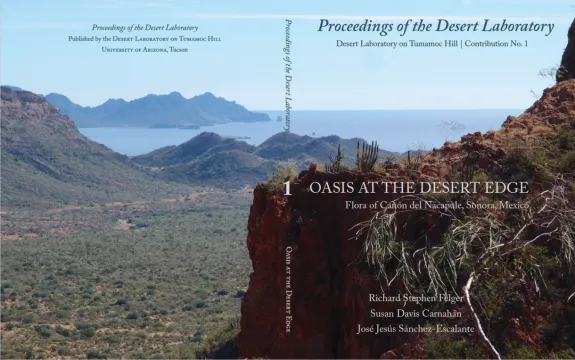
Oasis at the Desert Edge
Flora of Cañón del Nacapule, Sonora, Mexico
Contributors
Richard Stephen Felger
Susan Davis Carnahan
José Jesús Sánchez-Escalante
Summary
Cañón del Nacapule cuts into the southeastern flank of the Sierra El Aguaje, a rugged volcanic range about 20 kilometers northwest of Guaymas. Nacapule is included in the Sonoran segment of the Gulf Coast subdivision of the Sonoran Desert. The bi-seasonal (summer and winter) rainfall is highly variable. Many plants of tropical origin reach their northern limits in this region or do not extend farther north in the arid coastal desert of western Sonora. The vegetation in the canyon resembles tropical thornscrub and approaches the character of tropical deciduous forest in the wetter and shaded habitats, while the steep canyon walls and exposed habitats support desertscrub. The Nacapule flora includes 310 species in 233 genera and 72 families. The most diverse families are Fabaceae, Asteraceae, Poaceae, Malvaceae, Euphorbiaceae, and Cactaceae. Brief species accounts and identification keys as well as over 300 color photos are provided for the flora known from the canyon, nearby Nacapule Spring, and within 500 meters of the canyon mouth. Verbesina felgeri is endemic to the Sierra El Aguaje, and geographically isolated populations of tropical genera such as Aphanosperma, Briquetia, Coccoloba, and Ficus occur in the canyon. Plants not native to the Guaymas region, mostly Old World weeds, are represented by 19 species, three of which are not established as reproducing populations, including Corchorus olitorius, a new record for the state of Sonora. The canyon is managed for ecotourism by the local property owners, restoring earlier habitat degradation. Cañón del Nacapule, with 291 native species, provides conservation for 42% of the total native flora (ca. 700 taxa) of the 532,000 hectares (5320 km2) of the greater Guaymas region.
Download the PDF of the Proceedings
Order a print copy to be delivered to your home
Interested in other Proceedings of the Desert Laboratory? Want to learn more about this scholarly endeavor?

